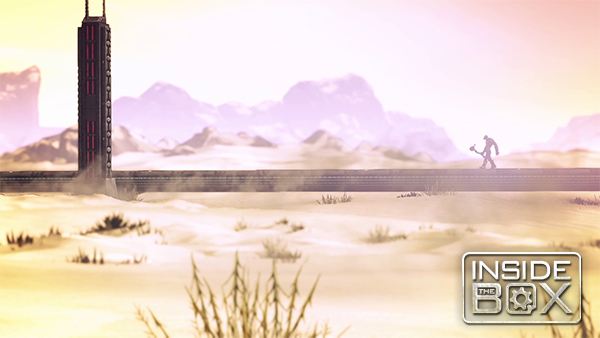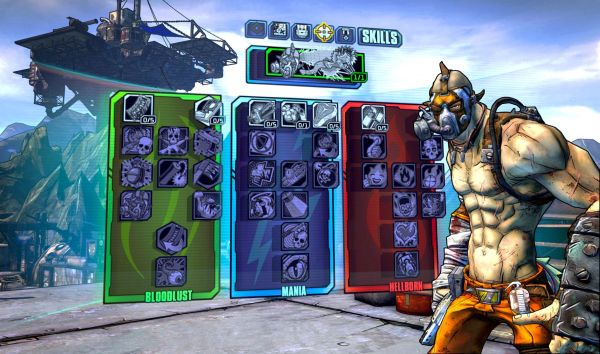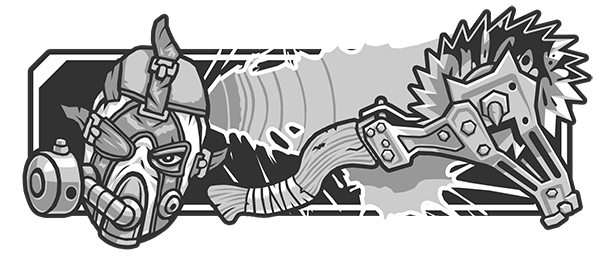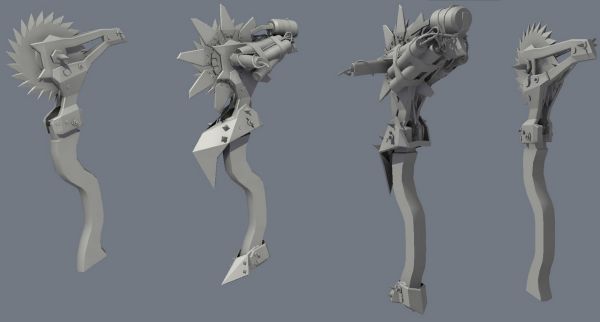Inside the Box serves as a forum for individuals involved in the production of Gearbox Software content to share personal motives, methods, process and results. Gearbox Software projects are created by a diverse range of individuals spanning a spectrum of different backgrounds, interests, objectives and world views. The views and opinions expressed in this article are those of the author and do not necessarily reflect the official policy or position of Gearbox Software or any of its individual members outside of the author.
Paul Hellquist, the Creative Director and Lead Designer on Borderlands 2, here.
Two weeks ago I told you a bit about the history of how we came to decide on making Krieg the Psycho — you can catch up here if you missed it. This week, I’m going to go into more detail about the design, what my goals were, how they were achieved, and some of the hurdles we overcame.
As I was writing all this, I quickly realized that there was a lot I wanted to tell you about this process — about 4 articles or so worth of stuff! I didn’t want to stretch the content across 4 or more weeks so here’s what we decided to do:
On Friday, we’ll be releasing a short video that shows how Krieg the Psycho became a Vault Hunter — you can see a still from that video above. And in anticipation of that video, we’ll have a new Inside the Box every day leading up to it! Here is what I’m going to cover:
High Level Goals and the Evolution of Buzz Axe Rampage
After work finished on Sage (the internal code name for Sir Hammerlock’s Big Game Hunt) I had been busting my butt on Borderlands 2 at crunch mode levels of effort for a full year. I was getting a bit cranky and testy as some of my teammates can attest to. It was time for a break. I was fortunate enough to take a whole month off to recharge the batteries. I knew exactly the kind of character I wanted to design so upon returning I decided that I would take the reins of the Psycho design onto myself as Jonathan Hemingway, who was the lead on the other classes, had moved on to another project within the company.
I spent a week or two working on a rough skill tree with the help of Matt Armstrong, the Franchise Director for Borderlands and a brilliant designer in his own right. My goals were this:
- Capture the feel of being a Psycho bandit
- Explore some new ground for skills and skill trees
- Make it totally badass
Becoming the Psycho
There are 3 levels of the class design that are required to complete the first goal of capturing the feel of being a psycho bandit. The smallest level is an individual skill. This level is about providing skills that mimicked things that the enemies do to you. This is where Pull the Pin, Light the Fuse, and Hellfire Halitosis came from.
The next level is the skill tree. This level is the design of how all of the skills work together to create an experience or play style that incentivizes players towards behaviors that embody the essence of a Psycho bandit. The Mania and Hellborn trees were designed to encapsulate an entire aesthetic of being one of the Psychos that players have already encountered. Mania is about the capturing the full experience of the charging-at-you melee monster and Hellborn is about transforming into the always-on-fire Burning Psycho. The Bloodlust tree was designed to imagine the ultimate gun-toting Psycho, something that the game doesn’t currently have in any iconic enemy variant like the inspirations for the other two trees.
The final level of capturing the feel of a psycho is the action skill which sits above all of the trees and is the glue that connects them together and provides the element that all trees share. More than anything else this skill needs to embody the promise and flavor of the character. For Krieg, each of these three levels needed to drive the player to become a Psycho while playing the character. We wanted co-op partners of a Krieg player to watch them play, shake their head, and think, “What the heck is he doing? He’s crazy!”
Exploring New Ground
With Krieg I really wanted to stretch what we had previously been comfortable with in the design space for skills and skill trees. There was a lot of debate during the development of Borderlands 2 about the level of subtlety that would feel good in the main title. This debate resulted in us choosing to keep things more straightforward with the 4 baseline Vault Hunters.
This philosophy left some rich areas of skill and tree design open for Krieg. I really wanted to explore some of these spaces for a couple of reasons. The first was that I thought they would be fun! I thought they would be interesting and exciting to players, especially how late in the game’s life cycle that Krieg would be launching. The other reason was to gauge the reaction to the more advanced and intricate relationships between skills within the trees to see what the range for characters can be for Borderlands. The jury is still out on that.
More Badass, Please!
I really wanted the experience of playing Krieg to be badass. That was a goal for each and every character in Borderlands 2 so it was nothing new. Nevertheless, whenever you work on a new design it is important to remember the key goals you had previously to ensure that the new class, system, or feature does not forget the key elements of the entire game design.
Getting Krieg to feel badass mostly comes down to number balancing and audiovisual feedback when using the skills. Things like spraying blood on the camera during Buzz Axe Rampage, great sounds to make the axe feel powerful and strong, animations that gave his swings, throws and movement weight and power, and many other small things on lots of skills to bring the Krieg experience to life.
Evolution of Buzz Axe Rampage
As I mentioned in Designing Krieg, Part 1 I had a proposal for a Psycho from early pre-production that had been moth balled. The first thing I did was pull that out of the vault (Ha! Vault, get it?…I’m sorry). It turned out there wasn’t much there that I really wanted to keep and, in fact, only one skill from that treatment shipped with Krieg as part of the Hellborn tree — check back Thursday to find out which one!
I basically started over since we had so much more knowledge about how to make characters, what worked well, and what didn’t work well for Borderlands 2 compared to when I had come up with that early tree. For one thing that pre-production tree used the Borderlands 1 template of 21 skills, not the 30+ skills of the new trees in Borderlands 2.
Whenever we are making a Borderlands character the first thing that needs to be determined is what the action skill will be as it creates a framework for the gameplay loops that players will be doing as well as a foundational element for many of the skills in the trees. I quickly looked at our Psycho enemies for inspiration for the action skill. The first version of the action skill during this phase of development was this:
Pyromania
The Psycho lights himself on fire and equips a flaming buzz axe.
Melee attacks have an X% chance of lighting enemies on fire
Pyromania only recharges when taking damage.
As you can see this is much closer to the final skill compared to “Psychotic Fit” from my pre-production treatment with the significant difference being that fire was a major theme of the action skill itself.
So now I had an action skill. The next step was to figure out the themes for the trees. I knew I wanted a tree all about kill skills since I thought this was an area of class design that we had more room to explore. I also wanted a tree about changing the player’s relationship with taking damage, and one about changing the relationship with being on fire. For this revision the trees were called Bloodbath, Mania and Face Melter, respectively.
Then it was time to flesh out the 3 trees on paper. This process takes a couple of days. Once the trees are filled out the next thing you do is stare at the skills…for a long time. At least, that’s what it looks like to any passerby who looks into your office. What you are really doing is playing the character in your head. You are looking for connections between the skills and looking for pitfalls in the design that need to be addressed by imagining what it will be like to use these skills. If we can play it in our head and imagine how that is going to feel, and what a player will be thinking, we can often do the first major iteration without writing a line of code and save ourselves a lot of time.
Untextured early study of the buzz axe with and without the attachments added by skills.
I asked Matt Armstrong to stare at the trees with me for a while. The first thing our imaginary play session discovered was that the Pyromania action skill would be problematic. The design goal was to turn you into the Burning and Hellborn Psychos that you had fought throughout the game. The problem was that having the skill light you on fire when it was activated created a major burden on all of the trees to deal with the fact that you were going to be on fire all the time. We either needed to (A) make him immune to fire damage from the action skill or (B) add skills to the Bloodbath and Mania trees to take advantage of the fire.
I didn’t want the entire character to be defined by fire so option B was a non-starter. Immune to fire was bad for a bunch of game balance reasons, most notably being that many enemies in the game would be zero threat to him. Aside from the balance problems, I also felt it was important for the fire to still damage the player in order to make players feel like they inhabited someone who was psychotic and crazy. So we needed a plan C.
Plan C was was to remove the whole fire portion of the skill and focus on the baseline psycho enemy’s ability to charge and slug enemies. When we looked at this new action skill it boiled down to “more melee damage” and was kind of boring so the first thing we did was add the axe throw to the skill. At the time throwing the axe was a mid-tier, one pointer in the Bloodbath tree. The axe throw ability added more unique gameplay options and excitement to the skill and was also something Psycho enemies do to players all the time. It was clearly a great fit. Now that the fire theme was gone the skill was renamed Buzz Axe Rampage.
We were now in a good solid place to start development on the skill. Gameplay Programmer Daniel Algood then wrote the code for our action skill. The goal of the first implementation is simply to represent all of the functions of the skill. Something many people don’t understand is just how rough prototypes really are. Below is a video of the first implementation of Buzz Axe Rampage.
A glimpse at the initial prototype for Krieg the Psycho’s action skill
As you can see, it’s not as polished of an experience that players of Krieg are used to. This example brings up an interesting professional skill that many don’t realize is a key aspect of development: imagining how work-in-progress features will function once complete to recognize the difference between features that will be great once finished and the ones that never will pan out. Usually Designers and Creative Directors must flex this muscle the most and help explain that vision to other team members. In the grand scheme of things, I’m sorry to say, it’s likely that tons of awesome ideas have never shipped because of developers not being good at this skill. The flip side is also true. In my experience, tons of terrible ideas have never shipped because team members have correctly identified the ones that never will be good. Recognizing the difference between the features that will be great and the ones that won’t is one of the reasons why making great games is so hard. OK, digression complete!
It was another couple of weeks before the action skill and trees were mature enough to evaluate how they were working out. The first tree that was finished enough to test was Bloodlust. I worked very closely with Andrew Hoffman (Lead Quality Assurance Tester for Borderlands 2 DLC) to get feedback on the action skill. The first thing that Andrew noticed was that it was very easy in the Bloodlust tree to forget about the action skill entirely as the tree’s power was not coming from the action skill. Also, he said that every time he tried to use Buzz Axe Rampage he just went down before he could really do anything with it. So I had two problems to solve.

No sandwich mechanics!
The bigger of the two was the fact that you went into Fight For Your Life before you could have any fun with the skill. The obvious answer was to add health regeneration or massive damage reduction to the action skill to give Krieg survivability during the skill. It was at this moment that I made up a rule for his skill designs. The rule was, “No Krieg skill should ever encourage taking cover, hiding, or stalling to gain an advantage.” This rule was to avoid a tactic that many players used with Brick in the first Boderlands, which was to get into combat, kill everything with your guns, and then use the action skill just to stand around yelling at the top of your lungs regenerating health between combats while the gamer went to the kitchen to make a sandwich. (In fact I actually call these types of mechanics “sandwich mechanics.” A term I learned from the vets at Looking Glass Studios when I was just starting out.) That behavior was not in the spirit of Brick and I wanted to ensure that this kind of tactic was not a viable option Krieg players. Health regeneration broke this rule because you could activate the skill solely for that benefit just like Brick. Damage reduction might work, but wouldn’t enhance the experience of becoming a Psycho.
I needed a mechanic that encouraged players to behave like a psycho bandit by charging into combat not shying away from it. That is when I decided to add the full health refill with every kill to the action skill as that mechanic would reward players for continuing to attack instead of retreating. There were still concerns for quite a while after I added the health refill on kills and it really wasn’t until the addition of the “hard flinch” reaction of the enemies to the thrown axe that the survivability of the Buzz Axe Rampage was solid enough to be a fun challenge that was sustainable with skilled play.
That is all I have for now. Tomorrow I’ll go in depth on the Bloodlust tree.







